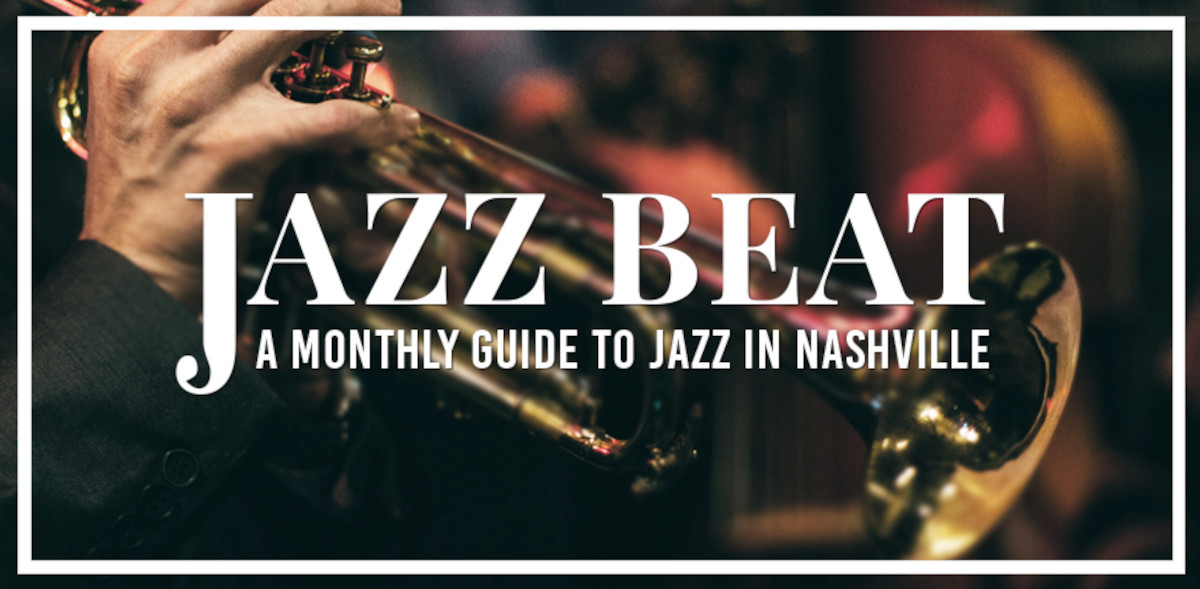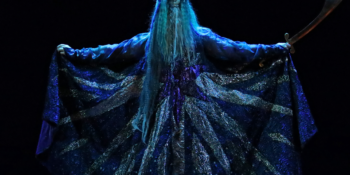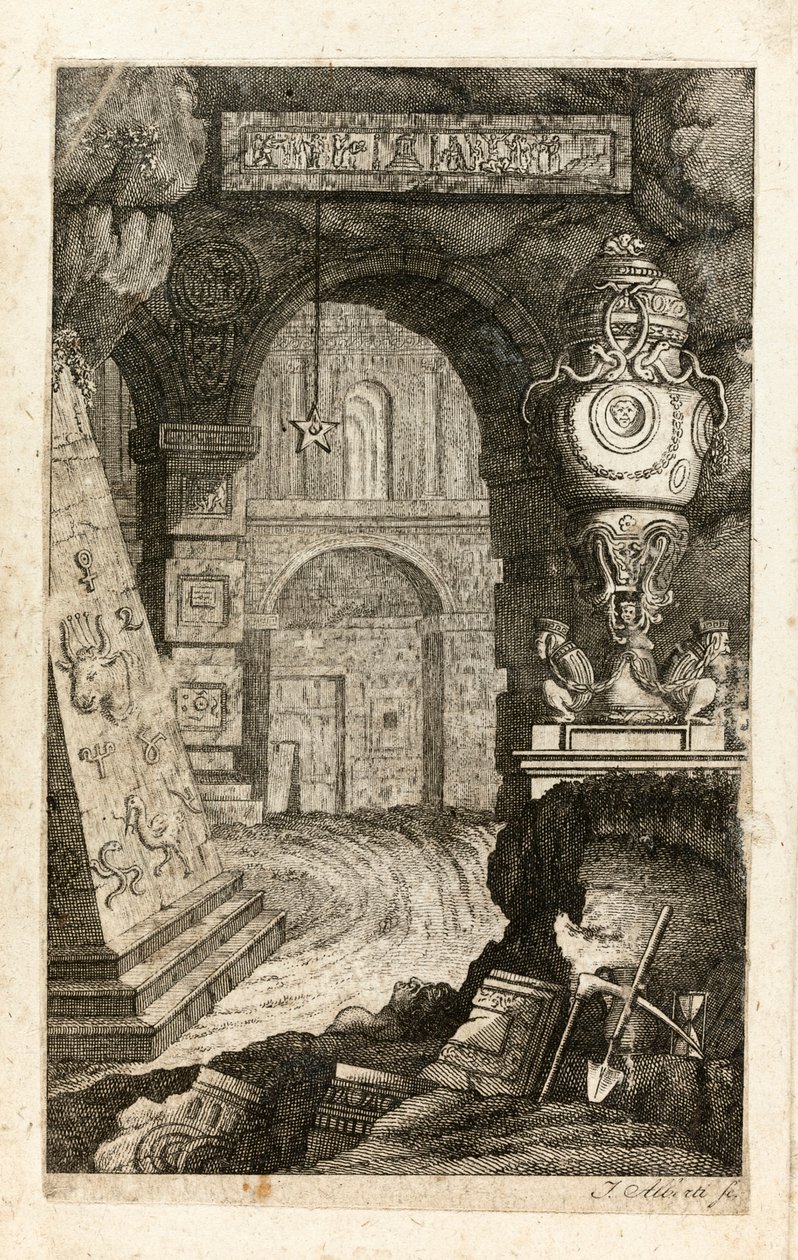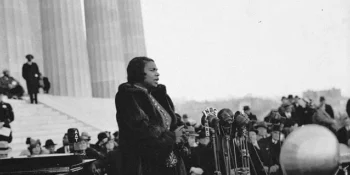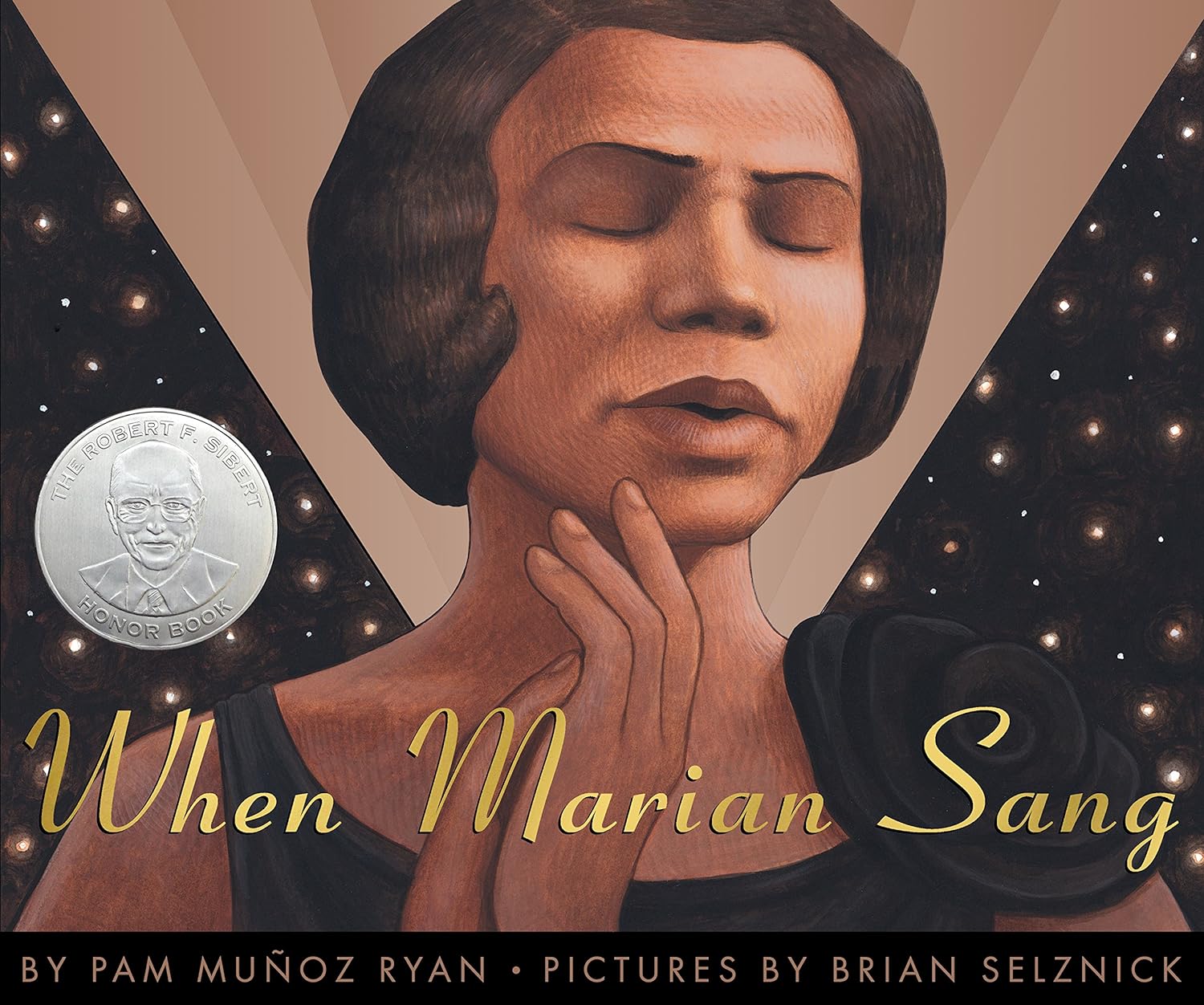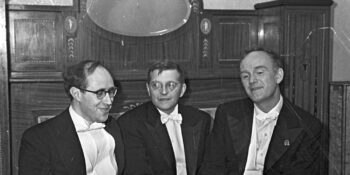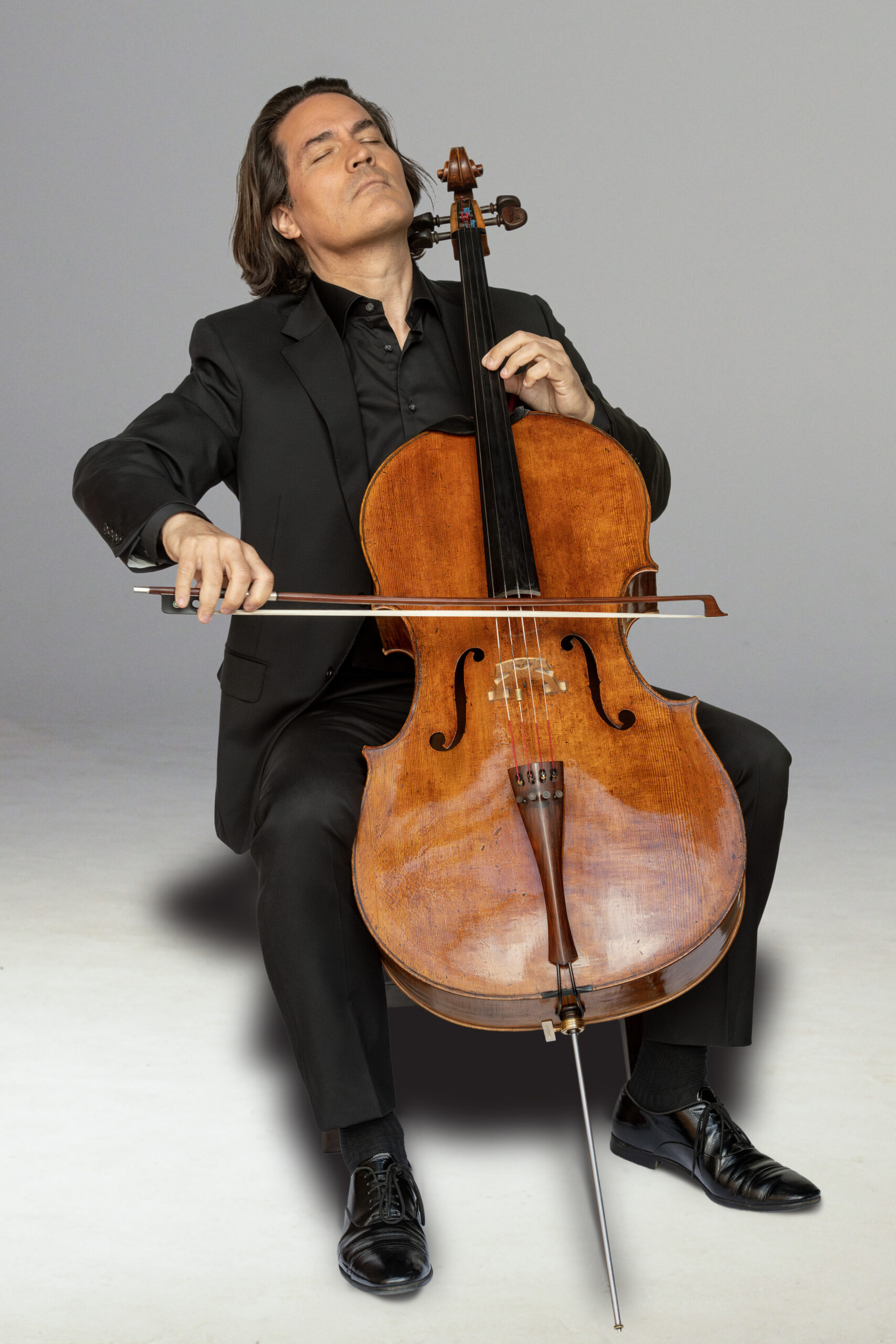Coming this Month:
The Jazz Beat: May, 2024
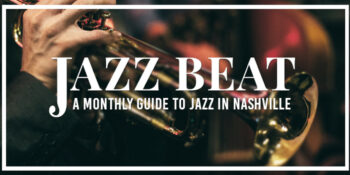
Hello, all, and welcome back to this regular column here at Music City Review. Here, we will update you with the most can’t-miss jazz events happening in Music City, so you can be sure to catch all your favorites, as well as discover new ones along the way. Get out there and support your local musicians and keep Music City thriving! We are always looking to promote great music that may not get the attention it deserves. Have an event you think should be included in the next issue? Email me at: JazzBeat@musiccityreview.com
This Month’s Highlights
Here you’ll find the shows and events this month that I think are the real standouts, unique events that you won’t find every day in the city.
Nate Smith & Friends – Monday, May 6 – 8:00 PM (Basement East)
Renowned jazz drummer, composer, and arranger Nate Smith makes a stop at East Nashville’s cozy Basement East. Smith’s work creates quite an impressive resumé, working with modern jazz legends from Path Metheny to Dave Holland to Ravi Coltrane, among many others. His debut album was twice nominated for a Grammy, and his body of work is only growing and diversifying, having ventured into the rock/pop world with collaborations with The Fearless Flyers, Brittany Howard, and others. For any fan of modern jazz and fusion, I think this is a can’t miss. Tickets can be purchased on the Basement’s website.
Jonathan Scales Fourchestra – Saturday, May 11 – 8:00 PM ($25) (Rudy’s)
Hailed as one of the most innovative steel pannists the world over, Jonathan Scales has spent his career redefining the expectations of his instrument. Presenting compositions that are complex and difficult yet accessible and danceable, Scales and his trio of top-notch performers offer a truly unique experience.
Cory Henry – Sunday, May 12 – 7:00 PM (Basement East)
Also at the Basement East is jazz and fusion organist and pianist Cory Henry. Originally of Snarky Puppy fame, Henry ventured out into a solo career beginning in 2018. His latest album Church was released this year, and his Nashville stop is in support of this new release. Tickets can be purchased on the Basement’s website.
Jazz on the Cumberland – Sunday, May 12 – 5:30 PM (Nashville Cumberland Park)
The Jazz on the Cumberland series returns for this year, starting with May’s edition on Mother’s Day. This free concert series is a local favorite, and has been ranked as one of the top destinations for jazz in Nashville multiple times. You’ll enjoy great jazz music accompanied by a variety of food trucks and the scenic downtown skyline.
Nicole Zuraitis Trio – Monday, May 13 – 6:00 PM ($15) (Rudy’s)
NYC-based Nicole Zuraitis is a celebrated vocalist in the modern jazz scene. A Grammy winner (as well as two other nominations), she has become a household name in the contemporary jazz landscape. Here she leads a trio, offering some of her wonderful original music.
Martinis & Jazz with Nashville Pride – Thursday, May 16 – 6:00 PM (Center 615)
The annual Nashville Pride fundraiser returns this month, with proceeds supporting the work the organization does all year long. Located at Center 615, your ticket includes complimentary craft cocktails, beer and wine, appetizers and treats, and live music throughout the event, as well as access to the Silent Auction and the Wine Pull. This is the perfect opportunity to directly support Nashville Pride while connecting with the community. Tickets are $50 and can be purchased through the Nashville Pride website.
Marcus Miller at Schermerhorn Symphony Center – Wednesday, May 22 – 7:30 PM ($40+)
Celebrated bassist Marcus Miller will perform with the Nashville Symphony, conducted by Enrico Lopez-Yañez, Principal Pops Conductor of the orchestra. With a career spanning more than 30 years, Miller is widely regarded as one of the most influential artists of our time.
Arrington Vineyards
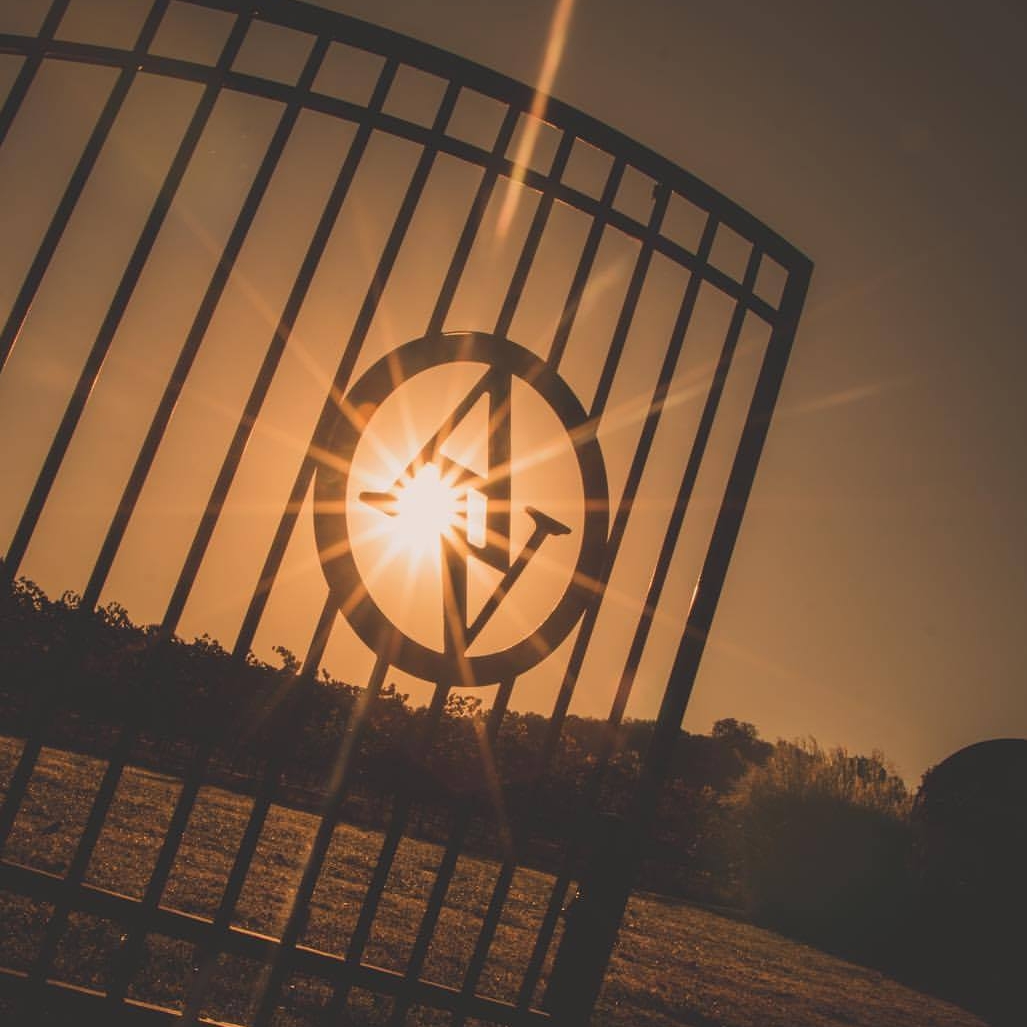
Music in the Vines Series – Every Saturday (3:00-7:00 PM) & Sunday (1:00-5:00 PM)
Starting in April, Arrington Vineyards will feature concerts of Jazz and Bluegrass every Saturday and Sunday. Acts range from Andrew Carney & the Essentials to Art Four Sale Band to the Reed Pittman Band. There will also be live jazz on Fridays (4:30-8:30 PM) for Arrington’s Food Truck Fridays!
City Winery Nashville
Nashville’s City Winery is a beautiful venue that consistently features top-talent acts that span genres from Jazz to Americana to Hip Hop. The below performances showcase a mix of several genres, but will certainly be of interest to any jazz audience. Enjoy these concerts accompanied by a stellar selection of wine and delicious bites.
The Lounge
“The Beatles: A Jazz Tribute” with the Miles Damaso Quartet – Sunday, May 5 – 7:00 PM ($18 Advance / $22 Day-Of)
Drummer Miles Damaso is accompanied by three of Nashville’s top musicians to offer a jazzy spin on Beatles’ classics. Damaso is a percussionist, educator, and composer/arranger who has experience in a number of genres and settings, including jazz, classical, and marching band. This quartet features Don Aliquo on sax, Pat Coil on piano, and Brian Allen on bass.
Main Stage
An Evening with Jonathan Butler – Sunday, May 12 – 8:00 PM ($35+)
Legendary South African singer-songwriter Jonathan Butler performs on City Winery’s Main Stage, supporting his most recent album Ubuntu, recorded in his home country. Butler will in fact present two sets, but as of this writing tickets for the 5:00 PM performance have sold out, so act fast if this is one you want to see!
Music City Without Borders: A Benefit Concert for NICE and Refugees in Middle Tennessee – Saturday, May 18 – 7:30 PM ($35+)
This benefit concert will feature a variety of acts and benefits the refugee population in the Middle Tennessee area.
An Evening with Leo Kottke – Sunday, May 19 – 7:30 PM ($30+)
Guitar master Leo Kottke will grace the Main Stage, showing off his trademark fingerpicking style that draws on a wide variety of influences, from blues to jazz to folk. After a long and successful career requiring the conquering of many personal hardships, Kottke is widely recognized as master of his instrument.
The Nashville Jazz Workshop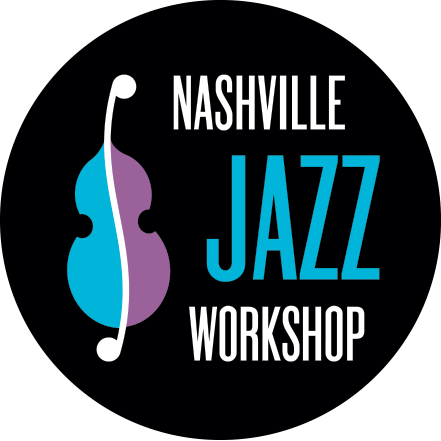
Moving on to Music City’s other great jazz venue, the Jazz Cave at the NJW is a venue with world-class acoustics, which consistently ranks in Downbeat Magazine’s list of Great Jazz Venues in the world. Tickets can be purchased through the Workshop website.
Jazz Cave
Chris Walters presents Rhapsody in Burlesque: A Tribute to George Gershwin & Cole Porter – Friday, May 3 – 7:30 PM ($35)
One of Nashville’s most celebrated jazz pianists presents a tribute to both George Gershwin and Cole Porter, two of the composers most instrumental in the early days of jazz music. An experienced composer and arranger in his own right, Christ Walters presents a unique reimagining of classic songs from the Great American Songbook.
Kyla Jade presents “The Great Women of Jazz” – Friday, May 17 – 7:30 PM ($35)
One of the most versatile and in-demand vocalists in the business today, Kyla Jade was a finalist on NBC’s The Voice, and is equally at home in a wide array of genres from pop to gospel to jazz. Jade will maker NJW debut with a reverent tribute to some of the great women in jazz history.
Adam McPhail: Tribute to the Great Blues Guitarists – Friday, May 24 – 7:30 PM ($35)
Continuing the Workshop’s theme of tributes for this month, standout Nashville guitarist Adam McPhail will pay homage to the great blues guitarists of the past. McPhail himself has performed and recorded with many of these towering names, including B.B. King, Keb’ Mo’, Cory Wong, Mark Lettieri, and Roosevelt Collier, among others.
Ralph T. Lofton presents The Timeless Gospel Music of the Hammond Organ – Sunday, May 26 – 3:00 PM ($30)
One of the most revered names in gospel music, Ralph T. Lofton has performed or recorded with giants such as Aretha Franklin, Stevie Wonder, Little Richard, Whitney Houston, among many others. After a long and impressive career which includes recordings with over 200 artists and many appearances on late night shows, among other achievements, Lofton now makes his debut as band leader, with Jay White on bass and Marcus Finnie on drums.
Mike Hicks – Friday, May 31 – 7:30 PM ($35)
Mike Hicks is an award-winning artist, multi-instrumentalist, and producer. Having performed or recorded with artists spanning from Buddy Guy to Rascal Flatts, the original music he now presents draws on a wide array of influences from jazz and blues to country, gospel, and R&B.
Community Events
Jazz on the Move: The Life and Music of Clark Terry with Rod McGaha – Sunday, May 5 – 3:00 PM (Frist Art Museum) (Free)
The latest installment in the Workshop’s Jazz on the Move series features a presentation on the life and music of one of the towering giants of jazz music, Clark Terry. This free event is presented by Rod McGaha, a direct student and protégé of Clark Terry, who has collaborated with revered acts such as Take 6 and Max Roach.
Champian Fulton: The Music of Billie Holiday – Thursday, May 9 – 7:30 PM (Franklin Theatre) ($40+)
The Franklin Theatre will host an evening of music paying tribute to the great jazz vocalist Billie Holiday. The performance stars Champian Fulton, celebrated as one of the most gifted jazz musicians of her generation.
Marcus Miller at Schermerhorn Symphony Center (detailed above)
Rudy’s Jazz Room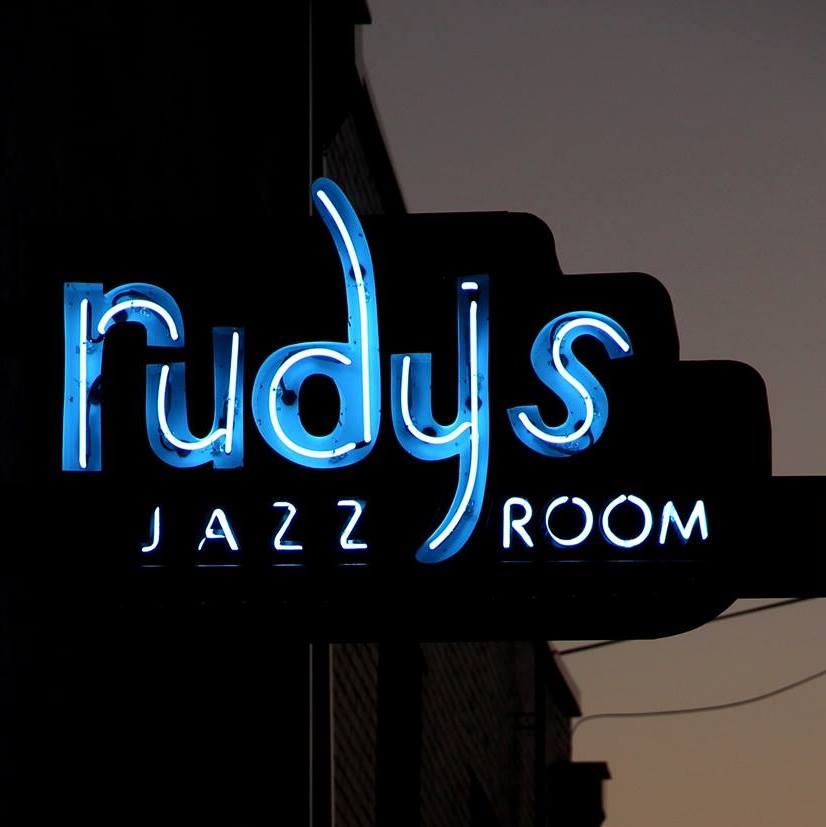
And now we move on to Nashville’s premier jazz club, with its cozy, intimate setting. I’ll start with some of the unique highlights for this month, then follow up with the great regular acts performing. Please note that some shows are one dollar cheaper if you purchase advance tickets. I have listed the door price for all shows.
Rudy’s Highlights
Below are the performances for this month that I’ve picked out as the real can’t-miss shows, some featuring touring artists from out of state, others featuring local artists giving specialized, unique performances.
Nigel Cathéy Quintet: Swingin’ Evening – Wednesday, May 1 – 6:00 PM ($14)
Trumpeter and arranger Nigel Cathéy presents an evening of hard swinging music that mixes traditional swing, hard bop and modern jazz to bring you a unique mix of sounds inspired by the jazz giants of the past, from Oscar Pettiford to Freddie Hubbard, to modern artists like Braxton Cook and Curtis Lundy. The band features Gus Arnold (sax), Josh Karas (piano), Patrick Atwater (bass), and Marc Widenhofer (drums).
Andy Reiss Quintet – Wednesday, May 1 – 9:00 PM ($15)
Grammy-winning guitarist Andy Reiss leads a stellar quintet of some of Nashville’s top musicians, including Joel Frahm (sax), Andrew Carney (trumpet), Rodger Spencer (bass), and Danny Coots (drums). Reiss, a member of the Time Jumpers, is a prolific recording session musician in Nashville, having recorded with greats like Slim Pickens, Pig Robbins, and Rebe McEntire, among others. His long career and life in music has given him a wide range of influences, from Jimi Hendrix and the Grateful Dead to Charlie Christian and Joe Pass.
Kyle Cox Quartet ft. Will Padgett – Thursday, May 2 – 9:00 PM ($12)
Nashville guitarist Kyle Cox returns to Rudy’s to provide an intimate evening of music from his impressive catalog, including his latest album WHO CARES, released last year. The quartet will feature Will Padgett on piano, with support from Paul Defiglia on bass and Ian Strobino on drums.
Cosmic Collective Fight Club – Friday, May 3 – 11:00 PM ($10)
Nashville-based jazz fusion group Cosmic Collective returns to Rudy’s for a performance of music that transcends genre, mixing jazz, pop, R&B, funk, and Motown. The lineup includes Tyler Enslow, Nikki Enslow, Don Aliquo, and Nioshi Jackson.
Artillerie Lourdes – Saturday, May 4 – 8:00 PM ($22)
Artillerie Lourdes is an acoustic group that brings you music inspired by the intoxicating Gypsy Jazz of Django Reinhardt and Stephane Grappelli. A perfect fit for Rudy’s to honor its French and New Orleans roots, the band features Derek Pell on violin, Issac Eicher on mandolin and Brook Sutton on bass, as well as the incredible Rory Hoffman on guitar and accordion. I have personally seen Hoffman perform on multiple occasions, and I will say his name alone should entice you to this performance.
The Aaron Lessard Group – Saturday, May 4 – 11:00 PM ($10)
Nashville jazz/fusion guitarist Aaron Lessard will perform a mix of original compositions and covers in a trio format featuring Brian Allen on bass and Mark Raudabaugh on drums.
Cinco de Mayo with Marcela Pinilla Jazz Trio – Sunday, May 5 – 6:00 PM ($15)
Celebrate Cinco de Mayo at Rudy’s with Latin-Jazz Colombian vocalist, percussionist, and songwriter Marcela Pinilla, backed by Isaac Eicher on mandolin and Geoff Saunders on bass. Pinilla has traveled the world with her music, with such achievements as holding a two-year residency at the legendary Jazz at South Bridge in Singapore, among many others.
Rebecca Carlson – Thursday, May 9 – 9:00 PM ($14)
Jazz and blues vocalist Rebecca Carlson has made a name for herself across the country, taking stints based in New York City, Tucson, Los Angeles, and now Nashville. An extensive touring and recording career has made her quite an in-demand performer.
Dave Potter Trio ft. Greg Tardy – Saturday, May 10 – 8:00 PM ($20)
Atlanta-based drummer Dave Potter comes to Rudy’s with a powerhouse trio featuring Greg Tardy on tenor sax and Will Goble on bass. A native of North Carolina, Potter has an extensive career performing and recording, having studied under and performed with some of the greatest in the industry today.
Marc Payne Quartet – Friday, May 10 – 11:00 PM ($10)
Young up-and-coming Nashville pianist Marc Payne performs with a quartet featuring Hugo Matile, Zachery Doughlas, and Darius Salazar. Payne has been immersed in jazz music for most of his life, and has soaked up the styles of diverse players like Art Tatum, Oscar Peterson, Sony Clark, Thelonius Monk, and many others to form his own unique style.
Jonathan Scales Fourchestra (detailed above)
Nicole Zuraitis Trio (detailed above)
Marc Payne’s JazzHop Quartet – Wednesday, May 15 – 9:00 PM ($15)
Marc Payne appears again, this time in a more contemporary setting, leading a band playing a fusion of jazz, hip-hop, and funk. The quartet features Zachery Douglas (sax), Darius Salazar (bass), and Hugo Matile (drums).
Danny Jonokuchi Quintet – Friday, May 17 – 5:30 PM ($15)
A jazz trumpeter, vocalist, and composer based in NYC and LA, Danny Jonokuchi has been recognized for his performance on two Grammy-winning projects. This performance will feature Jonokuchi in quintet format, presenting his original music, as well as new arrangements.
Le Boeuf Brothers – Saturday, May 18 – 5:30 PM ($20)
Twin brothers Remy (saxophone) and Pascal (piano) Le Boeuf are both Grammy-nominated composers and performers. This band will also feature Ethan Jodziewicz on bass and Jordan Perlson on drums. The brothers’ individual styles both overlap classic jazz with more modern styles, including indie-rock and electronic music, offering a modern and unique sound for their group.
The Karas Committee – Wednesday, May 29 – 6:00 PM ($12)
The Karas Committee is an original jazz-fusion project led by Josh Karas, an up-and-coming pianist, composer, and bandleader in Nashville. Backed by an incredible band, the group has already performed to sold-out crowds at Rudy’s as well as The Analog and The 5 Spot.
Rudy’s Regulars
Don Aliquo Trio – Multiple Performances
One of Nashville’s most active and accomplished saxophonists, Aliquo will be performing with his trio on two occasions this month, in both trio and quartet formats.
Don Aliquo Quartet – Friday, May 3 & Saturday, May 18 – 8:00 PM ($23)
Don Aliquo Trio – Saturday, May 11 & Saturday, May 25 – 11:00 PM ($10)
Jody Nardone Trio – Saturday, May 4 – 5:30 PM ($17) & Saturday, May 25 – 8:00 PM ($22)
Prominent Nashville pianist Jody Nardone brings his trio to Rudy’s for a classic jazz set. With a growing national reputation, Nardone seamlessly shifts from the “whispered beauty of Bill Evans to the percussive flights of McCoy Tyner.” (Michael McCall, Nashville Scene)
Cliff Richmond & the CliffNotes – Friday, May 3 – 5:30 PM ($14)
Guitarist and vocalist Cliff Richmond’s band always features some of Nashville’s top talent, and presents a great blend of soulful, swinging, and funky jazz.
Re-Evolution – Mondays, May 6, 20, 27 – 6:00 PM ($12)
This five-piece band is heavily influenced by classic jazz cutting-edge artists like Thelonius Monk, Wes Montgomery, John Coltrane, Bill Evans, and more. The band consists of Brian Cornish on saxophone, Regi Wooten on bass, Daryl Johnson on drums, Adam Charney on guitar and Alex Murphy on piano.
Dana Robbins Quintet – Wednesday, May 8 – 6:00 PM ($12)
GRAMMY-winning saxophonist Dana Robbins pays tribute to the Soul Jazz sound of the late 60’s and early 70’s, celebrating artists such as Les McCann, Eddie Harris, Jimmy Smith, and more. Robbins has either recorded or performed with many artists, including Keb’ Mo’, Aretha Franklin, Taj Mahal, Keith Urban, and more. Her band features David Santos (bass), Wes Little (drums), Phil Hughley (guitar), and Darius Mines (piano/B3 organ).
MILEStones: Tribute to Miles Davis – Wednesday, May 8 – 9:00 PM ($15)
The Nashville-based Miles Davis tribute ensemble returns to Rudy’s with the music of one of the greatest contributors to jazz music, with a focus on music from the two “great quintets” Miles led in the 50’s and 60’s.
Viktor Krauss – Friday, May 10 – 5:30 PM ($12)
Prolific Nashville bassist and composer Viktor Krauss has been a presence in the city for over 30 years, with nearly 500 album credits to his name. He has toured and recorded with countless big-name artists, including James Taylor, Tom Jones, Sheryl Crow, Robert Plant, and of course his sister Allison.
Sully’s Swingin’ Sunday Supper – Sunday, May 12 & Sunday, May 26 – 6:00 PM ($12)
Every other Sunday, Rudy’s features a Sunday dinner, with one of Music City’s top bassists Jimmy Sullivan leading a swingin’ jazz band featuring rotating special guests, for which a unique dinner special is served just for the show.
Geoff Pfeifer Quartet – Friday, May 17 & Friday, May 31 – 11:00 PM ($10)
Playing a mix of Wayne Shorter tunes and originals, Geoff Pfeifer brings gritty, edgy, genuine NYC-style jazz to Rudy’s stage with his Quartet.
PT Gazell & the Side Effects – Wednesday, May 22 – 6:00 PM ($10)
PT Gazell is a renowned harmonica player, with two Grammy-nominated albums to his name. He believes the harmonica is capable of so much more than most people realize, and continues to prove it by expanding the musical boundaries of the instrument.
Regi Wooten & Friends – Wednesday, May 22 & Wednesday, May 29 – 9:00 PM ($15 Cover)
Coming from a distinctly talented musical family, Regi Wooten is one of the most innovative and dynamic musicians on the scene today, pushing the boundaries of the traditional genres. Equally at home playing Hendrix as Wes Montgomery, Wooten assembles a group of some of Nashville’s best musicians to offer a night steeped in funk, jazz, soul, blues and rock.
Stephanie Adlington – Friday, May 24 – 8:00 PM ($23 Cover)
Another frequent visitor to the Rudy’s stage, award-winning vocalist, songwriter and vocal coach Stephanie Adlington is known as the “Siren of the South,” with an “unrivaled” take on the Great American Songbook.
Pat Coil Trio w/ Special Guest Joel Frahm – Saturday, May 25 – 5:30 PM ($17) & Friday, May 31 – 8:00 PM ($23)
Widely accomplished Pat Coil performs with his trio featuring Marc Widenhofer on drums and Rob Linton on bass, with special guest NYC tenor saxophonist Joel Frahm. All musicians involved are highly accomplished in their own rights, guaranteeing a stellar performance.
Chris Mondak Band ft. Special Guest Pavel Wlosok – Thursday, May 30 – 9:00 PM ($14)
Bassist and composer Chris Mondak leads his band with special guest Pavel Wlosok, a Czech-born pianist, composer/arranger, and educator who maintains a busy international touring schedule.
Giovanni Rodriguez & 12 Manos – Every Monday – 9:00 PM ($15)
A favorite on the Nashville Latin and jazz scene, multi-instrumentalist Giovanni Rodriguez presents an electric night of salsa, along with his band consisting of Rodriguez (bass/vocals), Melvin Macias (piano/vocals), Jesus Agreda (Timbales), Lorenzo Molina Ruiz (Trumpet), and Manuel ‘Manotas’ Ramierez (multi-Percussion).
Hot Club Gypsy Jazz – Every Thursday – 6:00 PM ($12)
Every Thursday night, Rudy’s honors its New Orleans and French roots by celebrating the vibrant music of Gypsy Jazz. These nights feature a variety of small groups either led or curated by New Orleans native Brook Sutton, all performing music in the style of the great Django Reinhardt and Stephane Grapelli. The bar will feature French Quarter-inspired cocktails as well as gumbo and beignets. Come out for as authentic a night as you can get without a trip to the French Quarter.
Rudy’s Jazz Jam – Every Sunday – 9:00 PM ($10)
I couldn’t make a list of Rudy’s events without including a shout-out for the regular weekly Jazz Jam the club hosts every Sunday night. Whether you are a jazz musician and you want to jam with your fellow artists, or you just want to come and enjoy what the local talent has to offer, the Jazz Jam is a great way to end your weekend.
Sambuca Restaurant
Sambuca is a New American restaurant in Nashville’s Gulch district, featuring nightly live music. Below are the appearances that will interest the jazz listener!
Leif Shires (2 performances) – Thursday, May 2 – 6:00 PM & Tuesday, May 21 – 6:00 PM
Modern jazz trumpeter Leif Shires will perform twice this month. Shires, who has performed with many artists including Tom Jones, the Secret Sisters, Kelly Lang, and many others, now presents a traditional, straight-ahead jazz sound that is sure to be a great accompaniment to a delicious meal.
Amanda Raye (2 performances) – Saturday, May 4 – 7:00 PM & Wednesday, May 15 – 6:00 PM
Although her style is a blend of soul and country, Raye’s jazz influence certainly shines through. She will present an evening of original music.
Steve Roper (2 performances) – Sunday, May 5 – 6:00 PM & Monday, May 20 – 6:00 PM
For three years, Steve Roper was the band leader and music director for the Steven Roper and the B.B. King Allstars band at the B.B. King Club here in Music City. His primary genres are jazz and blues, but his skillset extends well beyond these styles to R&B and even country.
Sarah J – Wednesday, May 8 – 6:00 PM
Known for her energetic personality and audience interactions, Sarah J presents a powerful blend of R&B, contemporary jazz, and pop music. She accompanies herself on both piano and guitar.
Thea Danos – Saturday, May 11 – 7:00 PM
Nashville native Thea Danos specializes in jazz and Brazilian bossa nova, a style she is intimately familiar with as she has spent extensive time in Brazil performing and perfecting her Portuguese singing. Danos likely will be the closest one can get to authentic Brazilian bossa nova in Nashville.
Stephanie Adlington (2 performances) – Saturday, May 18 – 11:30 AM & Sunday, May 26 – 11:30 AM
Featured above in the Rudy’s section, Adlington is an award-winning jazz vocalist.
Two Hands Restaurant
Sam Levine Trio – Every Saturday – 6:30-8:30 PM
Accomplished Nashville saxophonist and woodwind multi-instrumentalist Sam Levine performs with his trio at this Gulch café. Mel Deal on guitar, Charlie Chadwick on bass.
The Underdog Nashville
The Guthrie Trapp Trio – Every Monday – 8:00 PM ($10)
One of Nashville’s preeminent guitar talents will perform several times at the Underdog. More blues and country than jazz, Trapp’s intricate and highly technical guitar playing will surely interest those who love the technicality of jazz music. His trio features Jordan Perlson on drums and Tim Marks on bass.
The Jack Ruch Organ Trio – First Three Thursdays (2, 9, 16) – 8:00 PM ($10)
Guitarist Jack Ruch, organist Adam Wakefield, and drummer Nioshi Jackson make up this soul and blues trio. The music you’ll hear here makes up the core of jazz’s roots, so any jazz fan should feel right at home listening to this trio.
Song of the North: a Thousand-Year-Old Tale of Empowerment at Oz Arts
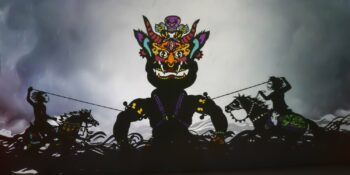
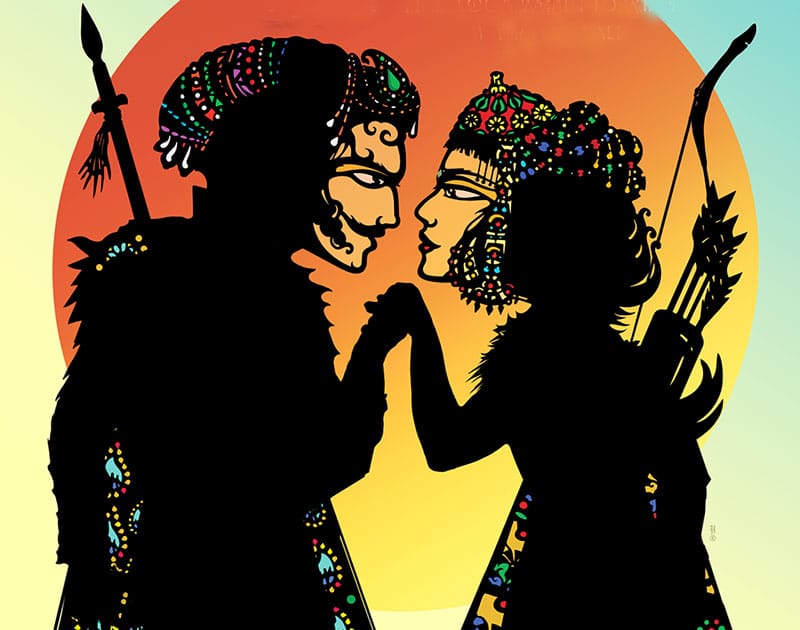
The longest epic poem created by a single author, Shahnameh, the Epic of the Persian Kings, tells the history of pre-Islamic Persia in 62 stories that amass 50,000 rhyming couplets. It is divided into mythical, heroic and historical ages leading from the creation of the world until the Muslim conquest of Iran in the seventh century and is often cited as the reason why the Persian language (Farsi) survived while other languages were taken over by Arabic centuries ago. Hamid Rahmanian’s Shadow puppet production, Song of the North, given at Oz Arts on April 19-21, adapts the Shahnameh tale of Princess Manijeh, a resilient heroine archer with an enchanting voice who must save her heroic Prince Bijan and stop her father’s war.
Rahmanian’s production is simply lovely. Projected from behind the stage onto a white screen, and complemented with sparse background animations, the story is told in a marvelous way. Most primary characters are embodied in stylized performance practice with projected masks. Prince Bijan’s (Clay Westman) hubris and daring, expressed with a puffed chest and exaggerated, raised fists is laughably heroic while Princess Minijeh’s (Sarah Walsh) reaching, imploring hands, accompanied by her enchanting song, are endearing and, coupled with Loga Ramin Torkian’s remarkable score (vocals from Azam Ali) the moments are downright captivating.
However, the real stars of the production are the over 500 puppets: the giant Demon is terrifying, and the two kings are so well depicted that I thought they were embodied like the other main characters. In the battle scenes (and chase scenes) the soldiers are appropriately menacing while the horses are all trusty steeds. Like the kings, the dance scenes incorporate puppets and embodied characters so well that your imagination no longer recognizes the difference.
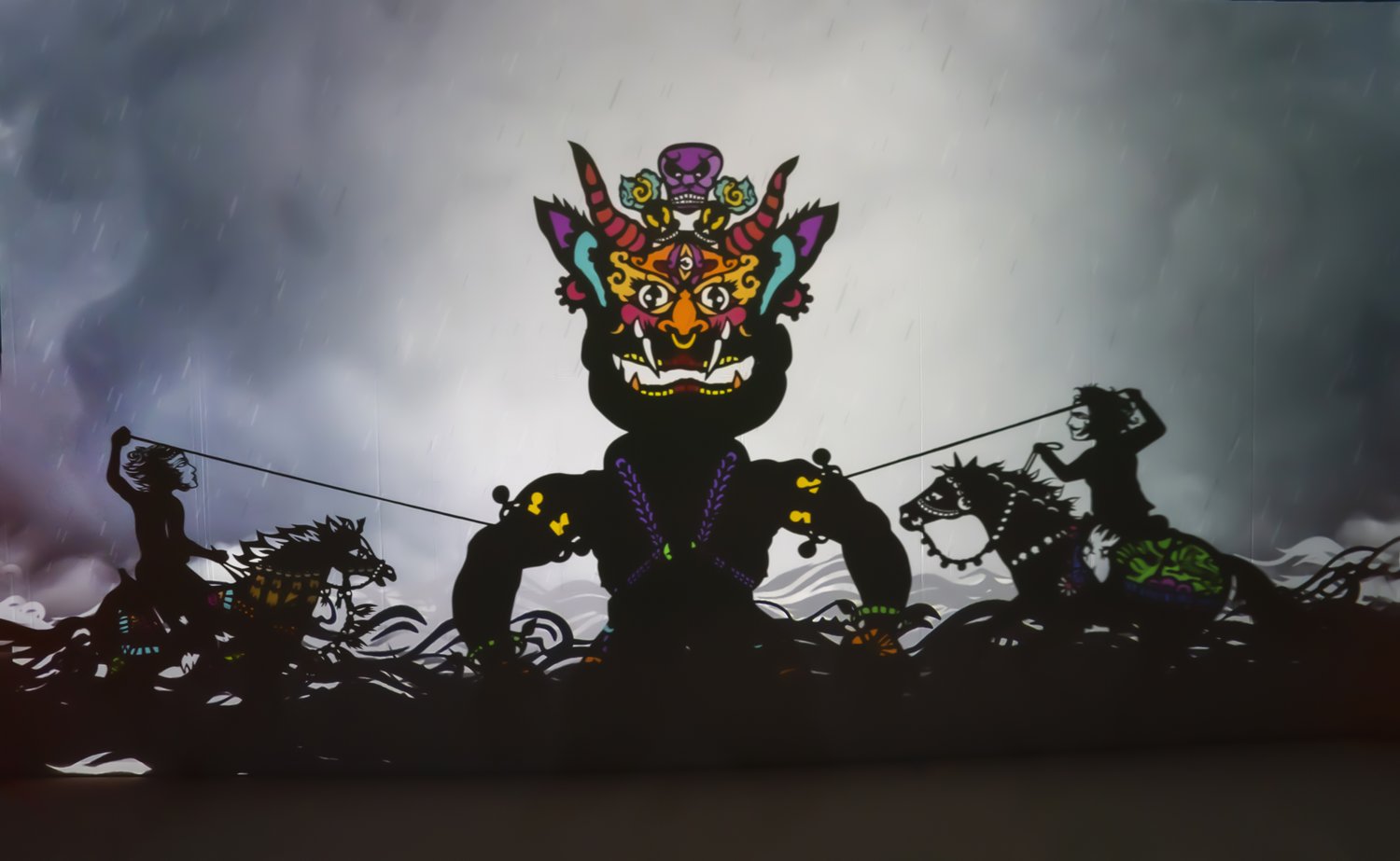
However, the beauty of the whole show didn’t hit home for me until the final applause when the crew came in front of the screen with each wearing the same black shirt with #womanlifefreedom imprinted across the front. Rahmanian then explained the reason for creating this show, stating that Iran has had a “bad reputation” in the United States for some time, and that he wished to create an alternative narrative. From this perspective, the Song of the North is a production that, even as it challenges the current mainstream western image of Persian (and Iranian) culture, it also provides an Iranian narrative that empowers and stands in solidarity with Iranian women in the face of the regime’s stepped-up repression and gender violence since the murder of Mahsa Amini in September, 2022. Although the show is past and it is unclear where it will appear next, the epic popup book is available here: https://www.kingorama.com/song-of-the-north
From the Nashville Shakespeare Festival
Hamlet
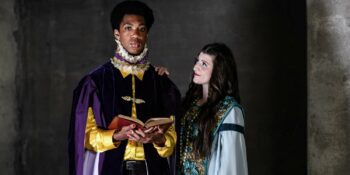
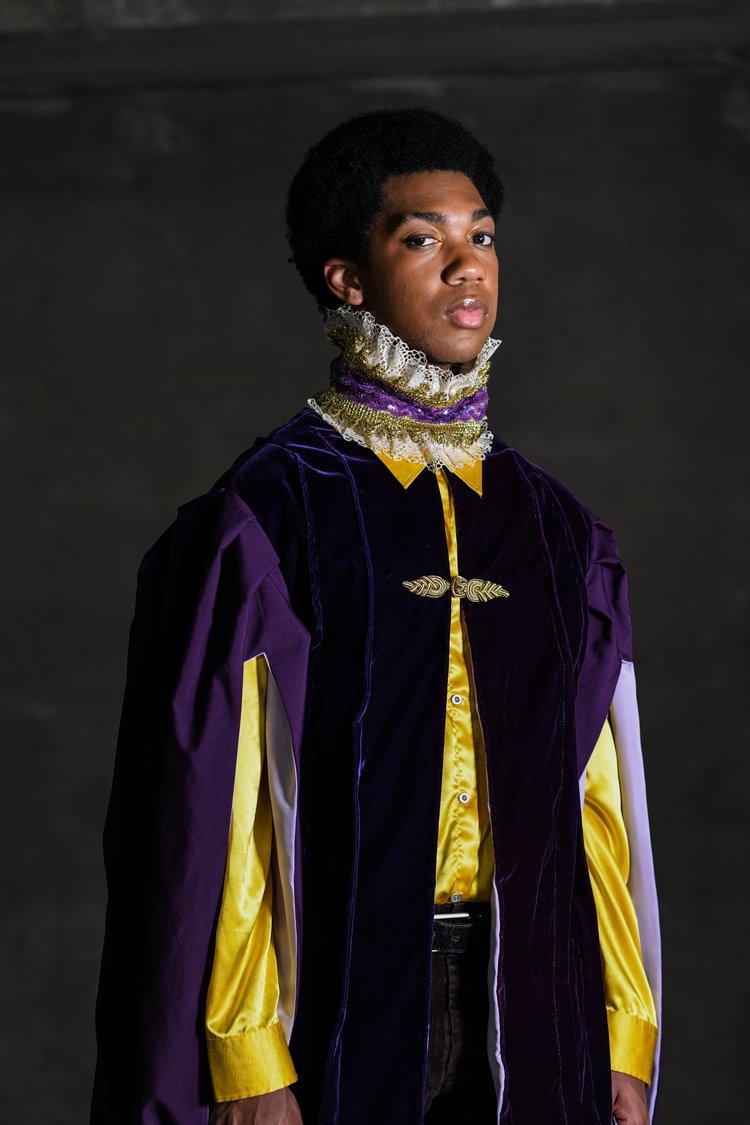
It seems to me that the primary difficulty, or “rub” in producing Hamlet, perhaps the most well-known play that Shakespeare wrote, and arguably the greatest play ever written (depending, of course, upon your rubric), is that so many of the lines have become memes in modern culture. From the Star Trek series’ appropriation of everything from lines to titles (e.g. Star Trek VI: The Undiscovered Country) to Disney’s adopting the entire plotline (Lionking 1994), to the modern FX television drama series Sons of Anarchy, the play is firmly entrenched in the modern psyche. The lines have taken up so much baggage in popular culture that it is easy to forget that they are utterances of characters with their own intentions, goals, reasons and dreams. The Nashville Shakespeare Festival’s wonderful production of Hamlet, going on now through April 28th, and in collaboration with Lipscomb University, realizes the bard’s original context with great intention and demonstrates why these lines are so important to western culture in the first place.
Take for example, the famous line: “To thine own self be true, and it must follow, as the night the day, Thou canst not then be false to any man.” These are spoken by the tiresome, longwinded bore Polonius as he bids his eldest son Laertes farewell. It was a stroke of genius in casting to alter this character to “Polonia” (now Laertes’ mother, and played by the veteran Denice Hicks). The line is an offhand remark, and in Hick’s deft delivery, the character becomes reminiscent of a meddlesome “Karen,” a woman and mother more interested in her own (and her familial) social standing than her children’s physical and mental health.
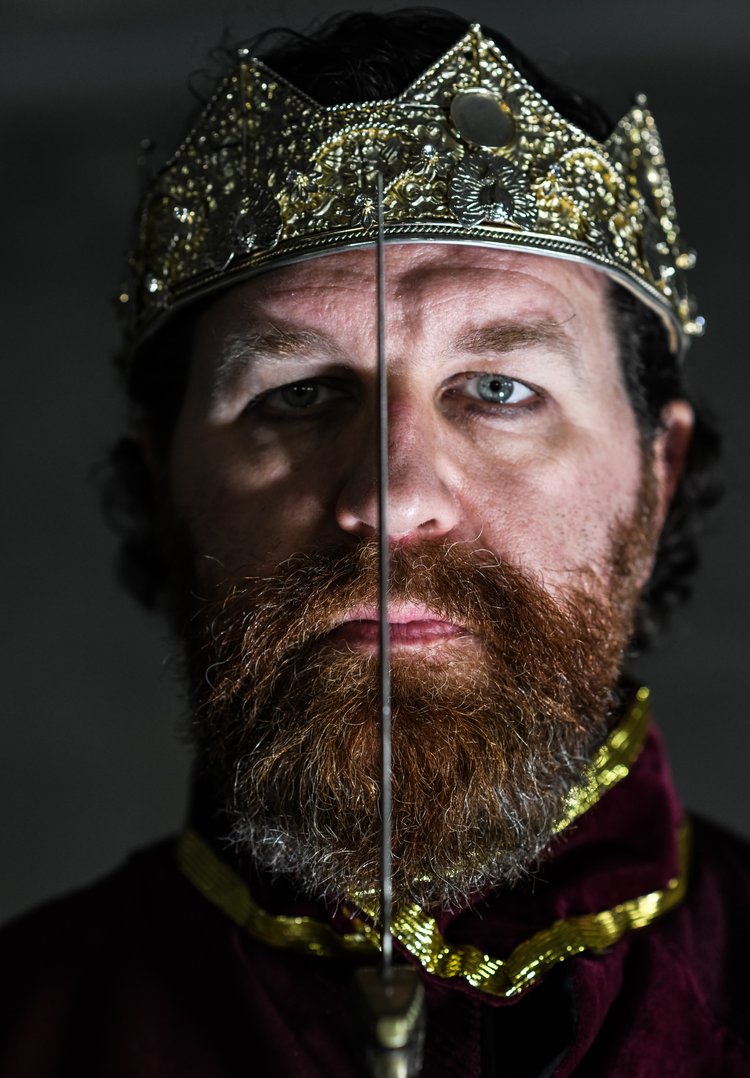
Unfortunately, this casting decision does create a slight (or actually highlight an already extant) tension in the plot. As a maternal figure, Polonia’s accidental murder attracts more sympathy than the male Polonius usually attracts, and certainly more than that expressed by Hamlet for committing the crime. In anycase, throughout the production, Hick’s comedic timing was unmatched. Her interjections during speeches or songs, “too long!” or when she doubled the gravedigger, singing Carole King’s “I Feel the Earth Move” she provoked the audience to laugh in spite of themselves, and provided an important foil of ridiculousness that functioned to enhance the tragedy.
Even more inspired is David Long III”s Hamlet. Charismatic and intense, Long’s reading of the part cleverly added a contemporary stylized and defiant flamboyance to the Prince’s feigned madness (at moments his presence and determination were remarkably reminiscent of that other artist, the one formerly known as Prince), and his biting cruelty to Ophelia is both shocking and chilling. His fourth soliloquy, “To be or not to be,” a sine qua non of the production’s success, was performed directly, without affect or pretension. It is read with a clear mind, as he is reasoning and determining the fate of Claudius in front of the audience. This moment of dark, intellectual reason and awful morality enriches and adds awe to this troubled character and he transformed it from the most famous line in theater to what it should be–a pronouncement from a desperately troubled man.
This is supported by Cleo Graham’s fetching, naïve Ophelia—when she and Hamlet sit on the stage’s edge and bicker (a modern-day Charles Kemble and Harriet Smithson) it was an appropriately heart-rending moment, steeped further by Graham’s eloquent delivery of the flowers scene—she brought to life the madness, love, and grief that inspired Hector Berlioz’s own mad “artist” two centuries ago. Regan Mills’ Horatio was fierce and as trusty as Alex Dee’s Laertes was heroic. As Rosencrantz and Guildenstern, Rachel Penner and Connor Adair were darkly hilarious, deserving of all that they got. I loved the way that June Kingsbury’s excellent costumes set them apart from the rest of the cast. D. Scott Baker’s Claudius was a perfect two-faced, calculating bastard whose lechery trumps his guilt–yet at moments it seems he might just love the regal Gertrude (Shannon Hoppe) as much as she loves being Queen. Jacob Allen’s sound design added a certain otherworldly nature to the play, reminding us throughout that it was a ghost that had inspired the events. I do wish that someday a production might show us the ghost (every production I’ve ever scene has him offstage with a disembodied voice) and there are some fabulous scores of incidental music for Hamlet that I would love to hear in a play setting, especially Tchaikovsky’s, but that might be a little expensive. Until then, this production is fantastic, and everything one could hope for—see it while you still can, it will be at Collins Alumni auditorium through April 28.
Latino en Nashville, Abril, 2024

English version here
La escena musical de Nashville se está ampliando en un energizante panorama de artistas y proyectos referentes de la música latinoamericana. Mariachi, Banda, Salsa, Cumbia y Rock en español, son tan solo algunos de los géneros que hacen vibrar las noches festivas de los locales. A continuación, una invitación para deleitarse en vivo con los sonidos y los pasos de tres agrupaciones artísticas que se presentarán en el mes de abril en el colorido escenario de la Plaza Mariachi.
MARROCKO 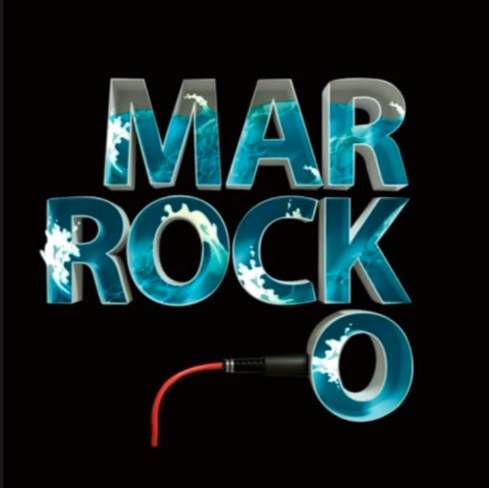
Saturday, April 20th
4:30 pm – 5:15 pm
Este dueto originario de la ciudad de Cali (Colombia) posee un estilo vanguardista en el que se fusionan el pop y el rock latino con los matices del folk indie. El guitarrista y productor Alex Zúñiga y el vocalista Guile Gadel reflejan en sus composiciones la frescura característica del rock en español y su lírica contemporánea. Dentro de sus producciones la banda cuenta con un álbum titulado “Mar de Rock” en el que sus canciones se alternan entre letras románticas y de introspección. La propuesta de Marrocko ha cautivado al público de la ciudad con presentaciones en el Nashville Shores Waterpark Latino Fest 2023 y el entretiempo del equipo local Nashville SC con un solo de guitarra que impregnó de energía a las barras presentes.
Redes sociales: Youtube Instagram Facebook
BALLET FOLKLÓRICO SOL DE MÉXICO 
Saturday, April 20th, 2:00 pm – 4:00 pm
Sunday, April 21st, 4:00 pm – 6:30 pm
Sunday, April 28th, 4:00 pm – 6:30 pm
El complemento perfecto en un show en vivo de Mariachi, Banda o Marimba son los auténticos pasos del folklore mexicano. El Ballet Folklórico Sol de México traslada a su público a los suelos de Sinaloa, Veracruz, Chihuahua, Jalisco y Chiapas donde se agitan con gracia los coloridos trajes de la región. Esta agrupación ha reencontrado a bailarines expertos con sus danzas autóctonas en una ciudad donde cada vez más la música mexicana se está posicionando en la expresión internacional. Su trayectoria en Nashville ya suma una década y entre su experiencia sobresalen participaciones como el lanzamiento de la cerveza Estrella Jalisco en el Nashville Music Center, así como el concierto de los Tigres del Norte en el Bridgestone Arena, siendo la primera agrupación folklórica en este escenario. Además de los eventos, El Ballet Folklórico Sol de México busca impulsar el interés y el aprecio por las manifestaciones culturales de México a través de visitas a las escuelas del área metropolitana y convocatorias para que nuevos bailarines hagan parte de su proyecto.
Redes sociales: Instagram Facebook
RITMO SABROSO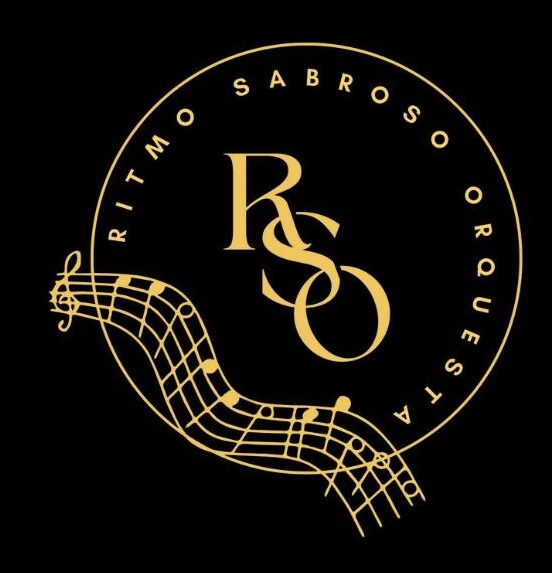
Saturday, April 20th
8:30 pm – 10:00 pm
Como su nombre lo dice, Ritmo Sabroso es una orquesta que inevitablemente pone al público de pie para unirse con sus pasos al ritmo de la salsa, el merengue y la cumbia. Estos géneros sin lugar a dudas han impregnado por generaciones las fiestas en el continente latinoamericano y la escena musical al otro lado del Atlántico. En esta agrupación se congregan músicos con una amplia experiencia originarios de Venezuela, Colombia, Puerto Rico y Estados Unidos, países representativos en la riqueza sonora y cultural de estos géneros. Para quienes estén buscando disfrutar de una noche tropical este fin de semana, ¡este es un evento que no se pueden perder!
Redes Sociales: Facebook Youtube
From Our Far-flung Correspondents Series:
Yuja Wang, Andris Nelsons and the BSO Tackle the Turangalîla-Symphonie
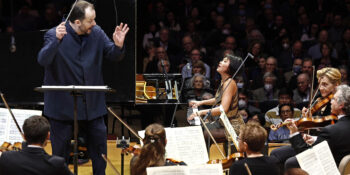
On the weekend of April 12-13 I was able to attend a musicology conference on music criticism at one of those fancy schools just outside of Boston, MA. During my visit, I was lucky enough to be able to attend Maestro Andris Nelsons and the Boston Symphony’s production of Olivier Messiaen’s rarely performed Turangalîla-symphonie with Cécile Lartegau on the ondes Martenot and Yuja Wang at the piano (Nashville last performed it in 2018, review here). Part of the Boston Symphony’s “Music for the Senses” series and performed exquisitely by the BSO, Messiaen’s giant symphony is a wonderful exemplar of the French composer’s sophisticated style, his various expressive passions (spiritual Catholicism, Eastern philosophy, nature, etc) as well as his related musical passions.
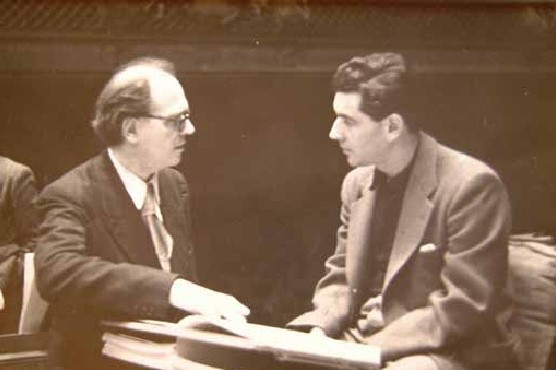
The work’s premiere is stacked with historical meaning that deserves mention. It was commissioned by Serge Koussevitzky on behalf of the Boston Symphony in 1946, just after the Second World War and just five years after Messiaen had been released from the Nazi work camp in Zgorzelek, Poland. Messiaen, who by then had become a very well-regarded Professor of Composition at the Paris Conservatory, had written a theme for organ, Tristan et Yseult – Théme d’Amour (“Tristan and Isolde – Love Theme”).
During the same period, his first wife, (violinist Claire Delbos) began to suffer a long decline in health—exacerbated by a catastrophic hysterectomy that left her with a brain infection and complete amnesia in 1949. From that point she would have to be institutionalized until her death in 1959. It is said that, apart from touring obligations, Messiaen visited her every day.
And yet, during the same period, Messiaen met and fell in love with Yvonne Loriod, a pianist and student of his composition studio at the conservatory. While the feelings were shared, they were not acted upon (Messiaen was a devout Roman Catholic and raising his son Pascal alone). Loriod described the situation as “…we cried for nearly 20 years until Claire died and we could marry.” Thus, instead of expressing his forbidden love, Messiaen composed monstrously difficult piano parts for the virtuosa Loriod, later stating that he allowed himself “…the greatest eccentricities in his scores because he know that she would master them effortlessly.” The Turangalîla-sinfonia , itself ten movements written for a huge orchestra, augmented percussion section , piano and ondes Martenot, was the central part of a tryptich that he developed out of his work on the Tristan und Isolde myth, and its piano part was written with Loriod in mind. It was premiered by the pianist and the Boston Symphony under Bernstein’s baton in 1949 (Koussevitzky had fallen ill). Famously and perhaps a little overtly jealous, on hearing the piece Pierre Boulez, who was also in Messiaen’s studio at the conservatory, called it “brothel music.” In Boulez’ defense, it is true that as opposed to Wagner’s guilt-ridden conceptualization of Tristan, for Messiaen the myth of Tristan and Isolde was an expression of the divine gift of physical and emotional love.
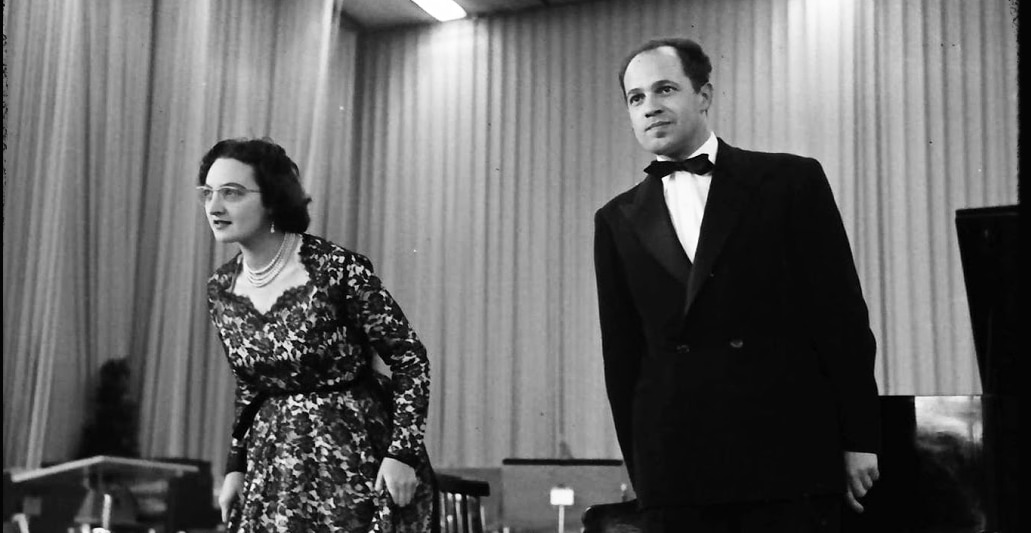
But the difficulties don’t only reside in the piano part. For example, Messiaen’s approach to rhythm is based on an organization built from duration instead of meter—an emphasis on the length of the notes instead of the recurrence of accent. These he adapted from Hindustani tālas. In the first movement, for example, the rhythms are based on the rāgavardhana, and lakṣmīśa tālas superpositioned on top of each other (these rhythmic organizations he also employed in the first movement of his Quartet for the End of Time). These were set against the powerful BSO trombones (Toby Oft and Stephen Lange) who were given the main theme of the opening movement (the “statue” theme). It was stirring, but not overwhelming—a difficult task and a complement to Nelson’s attentions to balance.
These rhythms, as well as other rhythmic devices (like the asymmetric augmentation of three rhythmic identities by the maracas, wood block, and bass drum in the third movement—kudos here to the BSO percussion section) and the perception of an organization that they create, even if the specifics of the organization that is beyond comprehension, are employed as allegory for the spiritual infinite.
Another source of inspiration was the Balinese Gamelan, for which the BSO prepared listeners with a wonderful preconcert demonstration by Gamelan Galak Tika. In the Symphony, the glockenspiel, celesta and vibraphone had a role that the composer described as very similar to the “East Indian gamelan.” It was delightful to watch Vytas Baksys (Celesta) and Jonathan Bass (Keyboard Glockenspiel) consult with each other and the score onstage, just before their third performance of the piece. Of course their performance came off without a hitch, but on Saturday night it seems that they were still earning things about the score!
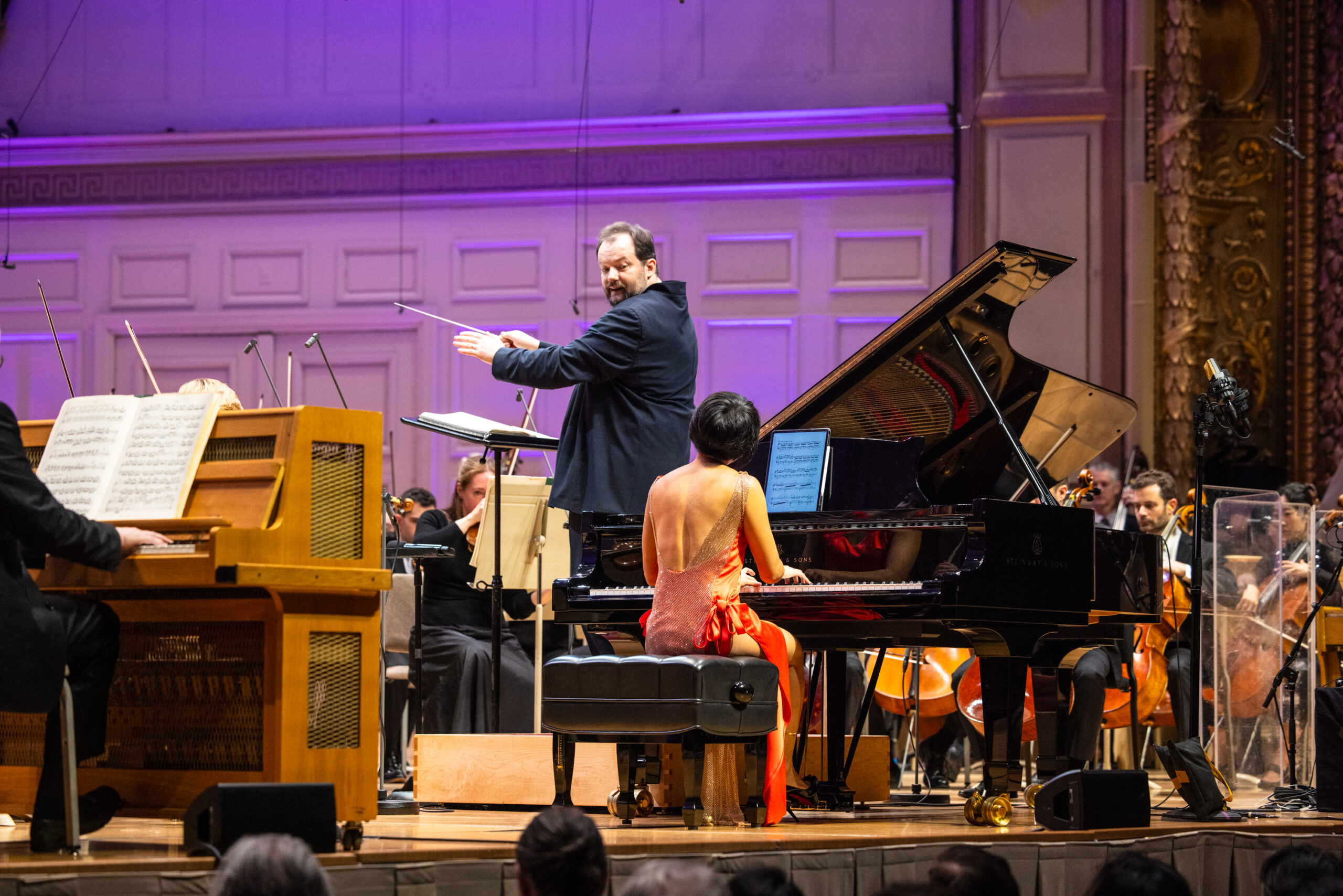
On the ondes Martenot, Cécile Lartigau performed wonderfully, with an attention to detail that corroborates her international reputation as a leading interpreter on the instrument—a part traditionally performed by Loriod’s sister Jeanne Loriod. Turning to the piano, Yuja Wang, an international star and sensation in her own right, proved herself up to the task of a part that essentially expresses virtuosity for the collaborative artist. Never one to sidestep the opportunity to undertake a performance of monumental size, for the evening Wang stepped from her personal spotlight to engage with the rest of the ensemble in this monumental work.
Most important was the clear connection Wang maintained with Nelsons throughout the performance. On Saturday night, after a huge cadenza, a couple of members cheered (they knew better but couldn’t help themselves). The glance between Wang and Nelsons was precious, as if to say, “yeah, whew!” –one wonders if that is the version that will make the recording? As part of this, her presence on the stage was not as a soloist, but a collaborative artist. One of the things that marked her interpretation was a patient and masterfully empathetic relationship with the rest of the ensemble’s performance.
Out of curiosity, I have created a miscellany of interpretations of one of the most beautiful moments of the symphony (the last page of IV, “Chant d’amour”) featuring some of the most famous interpreters of Messiaen. The collection appears in the video below. Of the group, the clear best is (predictably) Loriod, she simply blends perfectly with the ensemble, and maintains a pace that gives the moment the relish it deserves. Ruraro seems just a bit too loud and slightly disconnected with the ensemble while Thibaudet’s chords seem too heavy. MacGregor’s interpretation is quite interesting (distracted by a missed note in the ensemble) and in Wang’s I believe the overall tempo (probably Dudamel’s choice) was too fast. On Saturday, in Boston, the moment, perfectly given by both Nelsons and Wang, gave me the chills. However, perhaps the most poignant moment of the evening was Messiaen’s great, final, orchestral crescendo. Wang’s hands simply rested in her lap as the rest of the ensemble rose to the heavens (and the audience rose to its feet). I am very excited to hear this recording and hope to return to Boston soon!
Next up (April18-20) for the Boston Symphony Orchestra is Mozart’s Symphony No. 33, Anna Thordvaldsdottir Anchora and Hilary Hahn performing Brahms Violin Concerto.
Coming in July
Nashville Sonido Latino: July 2024
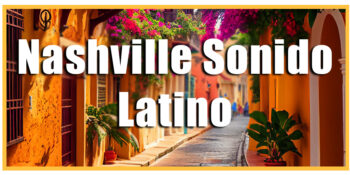
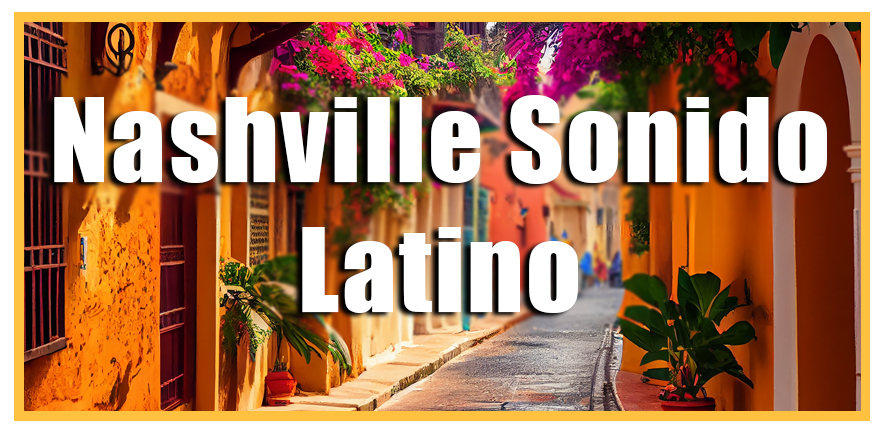
(Versión en español aquí)
GIOVANNI RODRÍGUEZ & 12 MANOS 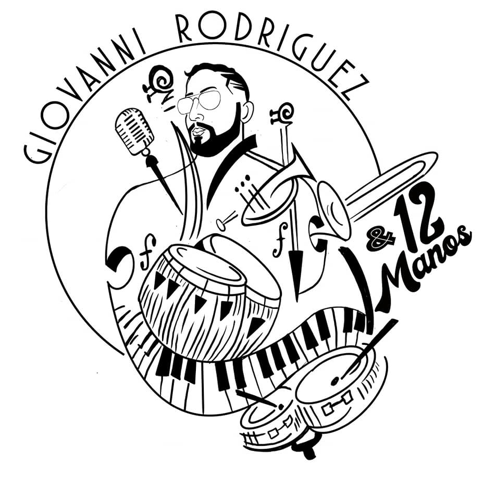
Rudy’s Jazz Room
Every Monday
9:00 PM
Tickets $19.44+
Social media: Instagram
Every Monday night at Rudy’s Jazz Room, the Caribbean sun rises with the beat of the congas as the night falls. Giovanni Rodríguez, a well-rounded artist of Dominican descent based in Nashville, is the director of this project, which also features outstanding musicians on the city’s music scene. The venue has a dance floor for this event to vibrate to the colorful rhythms of salsa, bachata, and Latin jazz.
LIRAN ROLL, INTERPUESTO, VÍCTIMAS DEL DR CEREBRO 
Ibiza Lounge
Wednesday, July 3
Doors open at 8:00 PM
Tickets $60+
These three Mexican bands come together to offer an unforgettable night in the style of the 90s. Metal, urban rock, blues, and ska are just some of the influences of these three groups that have dedicated their careers to preserving the authentic Latin rock style. Another great attraction of these bands is their Mexican cultural essence; their lyrics reflect beliefs, traditions, and everyday experiences in their country.
GRAN EVENTO CHAPIN
Toro Event Center
Thursday, July 4
Doors open at 8:00 PM
Presale $25
To the sound of traditional Guatemalan rhythms with the marimba orchestras, Maderas del Volcán, and Cubulco musical, will delight the public with a night of cumbia, marimba, and dancing. The versatile sound of these two groups lies in their blend of folklore and contemporary arrangements. Audiences of all nationalities will enjoy a joyful celebration combining the Caribbean’s sounds with the depth of wooden keyboards.
FIESTA DE TACOS 
Plaza Mariachi
Saturday, July 6
11:00 AM – 9:00 PM
Free admission
These are real tacos! A festival that will bring together the best flavors of Mexican gastronomy accompanied by a good mariachi. This event will feature ten local restaurants, that will offer an unparalleled variety of dishes and the protagonist will be this tasty corn tortilla.
FESTIVAL FRIDA
Plaza Mariachi
Saturday, July 6
12:00 PM – 6:00 PM
Free admission
What better way to interact with the impressive work of Mexican artist Frida Kahlo than with a festival that exalts her legacy. This event has prepared activities for children and adults to imitate her style, contests, fashion shows, crafts, live music, and much more!
BLUE ASHES DUO 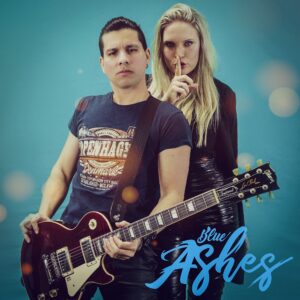
Plaza Mariachi
Saturday, July 6
4:30 PM – 5:15 PM
Free admission
This duo from Colombia and Denmark has an avant-garde style that fuses the rhythms of hard rock and rockabilly. Guitarist Alex Zúñiga and vocalist Shila Mariposa, infuse their characteristic style into classic rock covers, but also into their own compositions that can be appreciated on their production “Checkmate.”
GAPRI MUSIC
Plaza Mariachi
Saturday, July 6
5:30 PM – 7:00 PM
Free admission
In the heart of Caracas, Venezuela, Gapri Music was born, an artist passionate about the rhythm that flowed through the land that welcomed his Colombian family. Since he was a child, he was surrounded by tropical melodies, inheriting a passion for music that he has dedicated himself to throughout his life. The artistic journey that began in Táchira has taken routes to Colombia, Mexico, and now the United States, bringing a little of Venezuelan culture to its immigrant population.
THE KRAZY HOUR 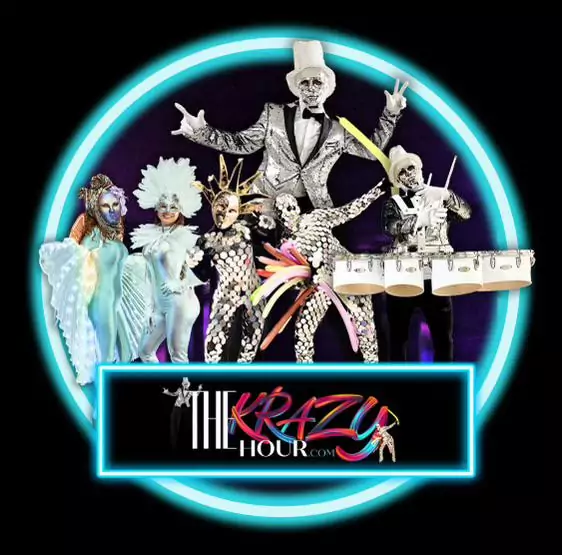
Plaza Mariachi
Saturday, July 6 and 13
7:30 PM – 8:00 PM
Free admission
At a wedding or a quinceañera, “la hora loca” is a must, that moment where protocol takes a backseat and all attendees gather in a carnival of music and revelry. The Krazy Hour is a project that elevates the meaning of this tradition to another level, providing an unprecedented fun experience.
NASHVILLE LATIN FUSION
Plaza Mariachi
Saturday, July 6
8:30 PM – 10:00 PM
Free admission
This project by Cuban pianist Melvin Macías integrates the style of Afro-Cuban jazz with ballads and other Latin American genres. The music of Nashville Latin Fusion reflects the experience and versatility of the musical career of its founder, who has not only experimented with the music of his region but even with different worlds such as musicals.
LABERINTO, LA FIERA DE OJINAGA Y GRUPO LOS DE CHIWAS 
Plaza Mariachi
Friday, July 12
9:00 PM – 2:00 AM
Tickets $70
Mexican regional music represented by the renowned groups of Laberinto, La Fiera De Ojinaga, and Grupo Los De Chiwas, will offer a joyful evening in the traditional style of Chihuahuan music and the norteño genre with saxophone.
RUMBA VENEZOLANA
Diamante Night Club
Friday, July 12
9:00 PM – 3:00 AM
Cover $30
This explosive party night will feature a vibrant mix of salsa, merengue, reggaeton, electronic, bachata, and vallenato, with DJ Caico – La Bestia Latina, and DJason Salsa spinning the tracks. Additionally, Ruso Tambor y Punto will deliver an impressive show highlighting the African roots in Venezuelan culture, with the drum as the main protagonist.
GRUPO FOLKLÓRICO RAÍCES DE MI TIERRA 
Plaza Mariachi
Saturday, July 13
12:30 PM – 1:30 PM
Free Admission
Grupo Folklórico Raíces De Mi Tierra transports its audience from the lands of Sinaloa to Chiapas, where the colorful regional costumes gracefully move. This group has brought together expert dancers with their traditional dances in a city where Mexican music is gaining increasing international recognition.
DURANGO FEST EN NASHVILLE TN
Plaza Mariachi
Friday, July 19
9:00 PM
Tickets $60+
A must-attend event for duranguense fans; it will feature a spectacular lineup with renowned representatives of the genre, including Montéz de Durango, Los Príncipes, Alacranes Musical, K-Paz de la Sierra, Patrulla 81, and Conjunto Atardecer. It will be an unforgettable night with the greatest duranguense hits.
RITMO SABROSO 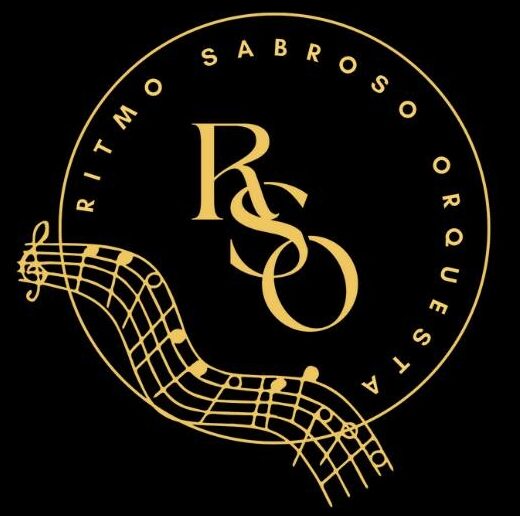
Plaza Mariachi
Sábado 20 de julio
7:00 PM – 8:30 PM
Entrada Libre
Social media: Facebook Youtube
As the name suggests, Ritmo Sabroso is an orchestra that inevitably gets the audience on their feet, moving to the rhythms of salsa, merengue, and cumbia. These genres have undoubtedly infused generations of parties across Latin America and the musical scene across the Atlantic. This group brings together experienced musicians from Venezuela, Colombia, Puerto Rico, and the United States, countries rich in the sound and cultural heritage of these genres. For those looking to enjoy a tropical night this weekend, this is an event not to be missed!
AGARRÓN DE JINETE JARIPEO 
Plaza Mariachi
Sunday, July 28
3:00 PM – 10:00 PM
Tickets $50+
This event will undoubtedly bring a lot of fun. Attendees will enjoy a spectacular showdown of riders with fierce bulls from Rancho El Semental. In this epic duel, Team Aventurero will face off against Team Tasajito. Music will be provided by Impala Norte and Tamborazo del Pueblo, adding rhythm and flavor to the afternoon.
Now My Favorite Color is Purple
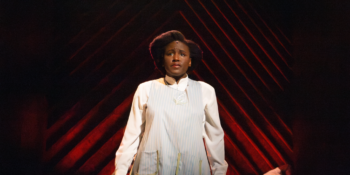
Sitting down in TPAC’s Polk Theater, the stage is distinctive, all dark, wide, wood planks. There is a slight platform in the center of the stage, and all entrances and exits are made through subtly hidden doors or doorways in the wooden walls. The backdrop is also all wood, the center of which has planks angled to form a simple, upward arrow. This stage sets a mood, indicating an aesthetically pleasing view of rustic Southern mid-20th century poverty. There are no sets in the musical because the stage is enough, and because the story and songs move so fluidly and quickly from one moment to the next that any attempt to have sets keeping up with that would become frenetic.
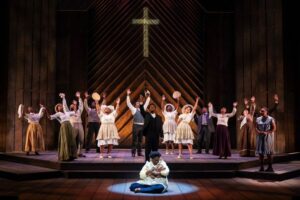
The Nashville Repertory theatre is performing the Broadway adaptation of The Color Purple, which is based both on the book and its film adaptation. I have neither read the book nor seen the movie (or the 2023 film adaptation of the musical), so my judgment of the story is based on this presentation, which I found to be excellent. The book is epistolary, which makes for great reading but presents a challenge when changing formats. The adaptation very rightly doesn’t try to force the play into that format. Some letters are exchanged, but there is no narrator or awkward plot framing: lighting is used simply and cleverly, beaming down when characters need to be separated or connected with others.
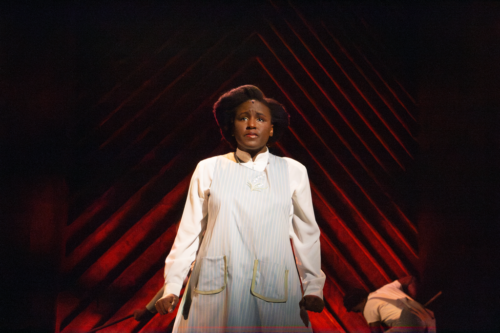
The story seems very bleak and unpleasant when written down summarily: Celie lives a hard life, abused by men and stuck in a situation that she thinks she can never escape. We meet her as a pregnant 14 year old African American girl living in a poor rural area in Georgia. After giving birth to her second child, her Pa gets rid of it in the same mysterious fashion he did with her other baby. She’s soon married off to Mister, an older local farmer who wants a wife to watch his kids and house, despite his irritation at her bad looks; he’d much prefer her younger sister. Her sister Nettie tries to come stay with them because Pa is making advances on her, but when Mister hits on her she runs off, promising to write to Celie every week. Time passes. Celie meets and admires two very different, independent women: Sofia, who marries Harpo (Celie’s stepson), and Shug Avery, the singer who is always accompanied by scandal. She learns what it is to develop strength in what seem to be impossible situations.
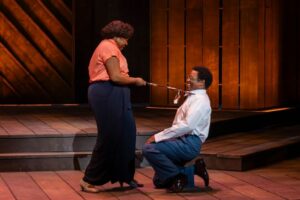
This all sounds like a character-building but difficult watch. Two things prevent that from being the case: first, the presentation of the abuse and hardship is so cleverly balanced. We’re not forced to watch extended scenes of physical abuse, like in Tina- The Tina Turner Musical. Instead most of the abuse is mentioned casually, as a matter of fact, making it invisible and yet all the more impactful: when Celie gives birth to what we find out is her second child, she gives it up to her Pa. Nettie asks why she gave the baby up and Celie answers simply, “Well, it’s his baby.” Ouch. Second, the musical is so very funny. Celie rarely is snide or cracks a joke, but most of the women, especially Sofia, are hilarious. Their wit and refusal to let men control them (despite the men’s best efforts) is entertaining to us and inspiring to Celie. There is no monotony of suffering.
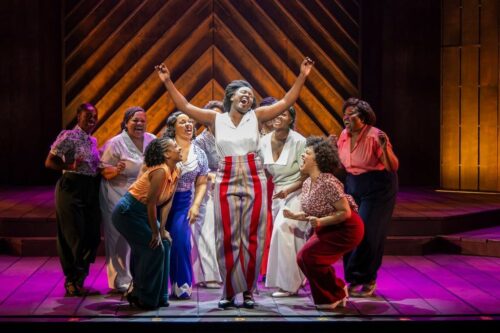
The only weakness in The Color Purple is its attempt to deal with theodicy. Celie, living her hard life, justly asks why a good God would let these things happen to her. This vital question is blurred, conflated with the discovery of self-worth, and answered by a non sequitur: God is inside her and in everyone else. This isn’t an actual answer to the question of why bad things happen to good people. The problem of evil remains: if God is in her stepfather, why would he still sexually assault her? However, the development of Celie’s character from abused child to a strong, independent woman, her growth through sisterhood, is an unequivocally inspiring story. And although it is fiction, it authentically represents the women who often go unmentioned: American history is full of African American women who have been handed an unfair, hard life, and who, through strength and community, have made the world a better place.
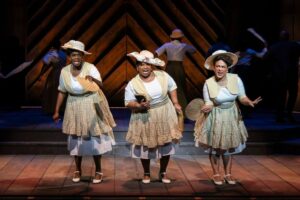
The music is great and has multiple styles: blues, soul, and gospel. The genre best suited to Broadway adaptation is probably gospel, because it requires vocal virtuosity and talented choirs. The Nashville Repertory does the music very well, with a strong band and fantastic singers. Most of the music is upbeat and fun, with the majority of the ballads in the second act. My favorite part of the music is the Greek chorus, three gossiping church ladies who talk over each other rhythmically and have marvelous harmonies.
Such a show requires real talent from every member of the team, and the Nashville Repertory Theatre provides it. The leads’ singing is virtuosic, the ensemble numbers are energetic. Joi Ware’s choreography is fun and matches the quality of the music. The cast is strong. Celie is played by Carli Hardon, who is absolutely lovely in the role. She plays child Celie with a natural youthfulness and her development from beaten-down woman to independent woman with a bedrock of strength is captivating. Her longing for the children she was forced to give up is moving. My favorite character in the play is Sofia, the healthy-minded, independent woman to whom Celie looks up as an ideal. Shinnerrie Jackson plays her with such good comic timing, with such hearty humor, and a fantastic voice. Tamica Nicole is Shug Avery, the sexy and scandalous singer who is another ideal and a love interest, voicing her role impressively. The men in the play are mainly abusive, but they aren’t one-dimensional. Elliott Winston Robinson plays Mister, and his portrayal of this unlikable man is nuanced. Gerold Oliver is Harpo, his son, who is a better man than his father, but who mistakenly wants to emulate him. His attempts at mimicking his father’s behavior is tragic and very funny, and his mixture of vice and virtue, of response to the generations of men in his family, develops naturally. The gossiping Greek chorus is played by Lindsey Kaye Pace, Yolanda Treece, and Meggan Utech, and they have incredibly tight harmony.
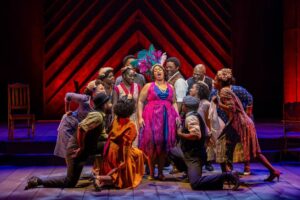
Nia Safarr Banks’s costumes and Joonhee Park’s scenic design are perfect for the musical, and Dalton Hamilton’s lighting is spot on. The band, led by music director Dion Treece, is great. Director Reggie Law has made sure the show is tight and impactful.
The Color Purple is a good show, whether you want something to provoke you to think, to examine African-American history, or you just want to watch a talented group perform an entertaining musical; it’s all of these things.
The Nashville Repertory Theatre will be performing The Color Purple at TPAC’s Polk Theater until April 14th. You can find more information at The Color Purple | TPAC and The Color Purple — Nashville Repertory Theatre.

